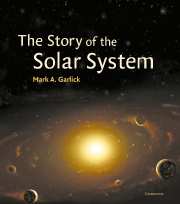Book contents
- Frontmatter
- Contents
- Miscellaneous Frontmatter
- Introduction
- Part 1 Genesis of the Sun and Solar Nebula
- Time zero: Giant Molecular Cloud
- 2 000 000 years: Solar Globule
- 2 030 000 years: Protosun
- 2 130 000 years: Solar Nebula
- 3 million years: T-Tauri Phase
- 3 million years: Outflow and Post-T-Tauri Phase
- 30–50 million years: The Main Sequence
- Part 2 Emergence of the Sun's Family
- Part 3 Solar System Past and Present
- Part 4 End of an Era
- Glossary
- Index
3 million years: T-Tauri Phase
from Part 1 - Genesis of the Sun and Solar Nebula
Published online by Cambridge University Press: 10 November 2009
- Frontmatter
- Contents
- Miscellaneous Frontmatter
- Introduction
- Part 1 Genesis of the Sun and Solar Nebula
- Time zero: Giant Molecular Cloud
- 2 000 000 years: Solar Globule
- 2 030 000 years: Protosun
- 2 130 000 years: Solar Nebula
- 3 million years: T-Tauri Phase
- 3 million years: Outflow and Post-T-Tauri Phase
- 30–50 million years: The Main Sequence
- Part 2 Emergence of the Sun's Family
- Part 3 Solar System Past and Present
- Part 4 End of an Era
- Glossary
- Index
Summary
By 3 million years or thereabouts – about 1 million years after the initial collapse of the globule – the protosun had shrunk to a few solar radii. Its temperature at the centre was now around 5 million degrees Celsius, while the surface seethed and bubbled at around 4500 Celsius. At last the object had crossed the line that separates protostars from true stellar objects. It joined the ranks as what astronomers call a T-Tauri star.
Named after a prototypical young stellar object in the constellation Taurus, the T-Tauri phase is one of extreme fury. And as with all T-Tauri stars, this earliest form of solar activity would have been driven – at least in part – by a powerful magnetic field. Because the gases inside the young star were by now fully ionised – a soup of positively and negatively charged elements – their movement as the star rotated effectively amounted to a series of gigantic electric currents. Thus the spinning star developed a global magnetic field in the same way that a wire carrying an electric current does – just as the Sun generates its field even today. During the Sun's T-Tauri phase, though, the star would have been spinning very quickly – once in 8 days compared with once in 30 days – spun up by the swirling gases that had ploughed into it earlier. This means that the T-Tauri Sun's magnetic field was much mightier than at present, and this is what made this phase in the Sun's formation so violent. The Sun was still surrounded by its protoplanetary disc. So, as the Sun whirled around, it dragged its magnetic field through this disc.
- Type
- Chapter
- Information
- The Story of the Solar System , pp. 18 - 19Publisher: Cambridge University PressPrint publication year: 2002



